Francis Pryor's Blog, page 25
December 2, 2012
Christmas Treats
Although I don’t believe in any of the religious stuff, Christmas does come at a very dark and brooding time of year. Very often, in England, we suffer from the Dog Days – periods, often lasting two or three weeks, when the weather is dominated by high pressure, with little rain or wind, but not much sunshine either and lots of what the weathermen call ‘mist and murk’ (never one or the other, always both together). These are conditions for doing short spells of intensive work outdoors, before retreating into the house, lighting a fire and opening a good book. Last Christmas I read all three books of that remarkable Millennium trilogy by the late Steig Larsson: The Girl with the Dragon Tattoo, The Girl Who Played with Fire and The Girl Who Kicked the Hornets’ Nest. And why isn’t their superb translator, Reg Keeland, given more credit? For what it’s worth (not much), my friend Alan Cadbury said he was inspired by them – which I think probably says more about him, than the books. I certainly couldn’t put them down, but they were more than rather loosely-edited thrillers: they took one into another realm altogether, with its own rules and values – something which, dare I say it, good literature has always done. So why, O why, is crime writing seen by academics and critics as ‘genre’, as something that doesn’t really merit close attention? If I were a betting man, I’d wager quite a lot that the likes of Conan Doyle, Dorothy L Sayers and Ian Rankin will survive into the 22nd and 23rd centuries, when other, supposedly more ‘literary’ writers will long have been forgotten. Anyhow, I’ll be reading Ian Rankin’s 12th and 13th Rebus books (The Falls and Resurrection Men), which clever Dick Alan Cadbury read when they first came out, back in 2001.
Variety is the spice of life, so unless I’m engaged in an all-encompassing marathon, like the Millennium trilogy, I also like to have a non-fiction book on the go too. And I like it even more if they’re written by friends, because Christmas can sometimes be a bit sticky, in a rather glutinous family sort of way, if you know what I mean. Too many smiles and coos, icing sugar and fixed smiles. From time to time I crave a bit of normality, when an old friend mutters something dry and a bit tasteless under his breath, which also smells slightly of gin. Not of course that I’m suggesting that any of the following would touch the stuff. No, far from it… But I digress.
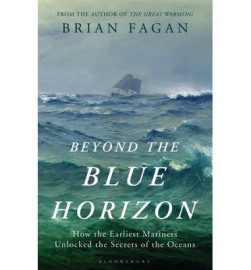 The first of my books is by an old friend who has inspired all of my writing – and again (and for the last time, I assure you) Alan loves his books, especially Time Detectives. Brian Fagan is undoubtedly the best known archaeological writer living today, and rightly so: his books are never, ever dull or repetitious. You can hardly turn a page of a Fagan book, without learning something new, and always written in a lively, but never patronising style. For my money, he’s perfection. Another thing about Brian is that he has a life. Too many archaeologists live for their subject to the exclusion of all else; and often it shows, not just in their writing, but when you’re with them in the pub. Ten minutes in their company, and I’m thinking about a stiff arsenic and soda. I promised I wouldn’t mention him again, but I’m afraid Alan can be a bit like that: obsessive, myopic. Brian has always been a keen yachtsman and sailor and also writes for the sailing press, so his latest book Beyond the Blue Horizon: How the Earliest Mariners Unlocked the Secrets of the Oceans (Bloomsbury) is particularly welcome. Yes, it’s closely based on sound scholarship, but you can also taste the salty spray as you read. A cracker.
The first of my books is by an old friend who has inspired all of my writing – and again (and for the last time, I assure you) Alan loves his books, especially Time Detectives. Brian Fagan is undoubtedly the best known archaeological writer living today, and rightly so: his books are never, ever dull or repetitious. You can hardly turn a page of a Fagan book, without learning something new, and always written in a lively, but never patronising style. For my money, he’s perfection. Another thing about Brian is that he has a life. Too many archaeologists live for their subject to the exclusion of all else; and often it shows, not just in their writing, but when you’re with them in the pub. Ten minutes in their company, and I’m thinking about a stiff arsenic and soda. I promised I wouldn’t mention him again, but I’m afraid Alan can be a bit like that: obsessive, myopic. Brian has always been a keen yachtsman and sailor and also writes for the sailing press, so his latest book Beyond the Blue Horizon: How the Earliest Mariners Unlocked the Secrets of the Oceans (Bloomsbury) is particularly welcome. Yes, it’s closely based on sound scholarship, but you can also taste the salty spray as you read. A cracker.
 I haven’t known Hugh Thomson anything like as long as Brian, in fact we only made contact a couple of years ago, when he was researching for the book, but we got on immediately – then it turned out we’d both attended the same college at Cambridge. Small world. Normally Hugh writes exploration and travel books often about South America: Cochineal Red: Travels Through Ancient Peru, is perhaps his best known so far, but he is also a distinguished film-maker. I suspect he’d be good at anything he turned his hand to – he’s that sort of person. He gave us a gorgeous amaryllis when he first came to visit and it actually bloomed six weeks later. I emailed him with the good news, and his reply came from Brazil, or was it Colombia – somewhere distinctly antipodean. But I digress.
I haven’t known Hugh Thomson anything like as long as Brian, in fact we only made contact a couple of years ago, when he was researching for the book, but we got on immediately – then it turned out we’d both attended the same college at Cambridge. Small world. Normally Hugh writes exploration and travel books often about South America: Cochineal Red: Travels Through Ancient Peru, is perhaps his best known so far, but he is also a distinguished film-maker. I suspect he’d be good at anything he turned his hand to – he’s that sort of person. He gave us a gorgeous amaryllis when he first came to visit and it actually bloomed six weeks later. I emailed him with the good news, and his reply came from Brazil, or was it Colombia – somewhere distinctly antipodean. But I digress.
This time Hugh is writing about his homeland and it’s a wonderful journey into the space that is not so Little England: The Green Road into the Trees: An Exploration of England (Preface Publishing). It’s a journey along the entire length of the Ridgeway and Icknield Way, with diversions to interesting places, such as Flag Fen, Must Farm and Seahenge. I’m told he also meets some interesting people. It’s a sane, wonderful book, written by an archaeologist who has stood to one side and can observe the world and its inhabitants with detached amusement. I plan to re-read it over Christmas. It’s that good.
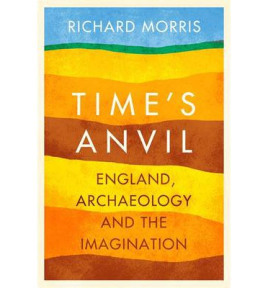 My last book is by far the most challenging, but that’s what happens when you try to do something genuinely new and original. It’s by Richard Morris, Time’s Anvil: England Archaeology and the Imagination (Weidenfeld and Nicolson). Like Hugh and Brian, Richard too has a life and in fact the first book of his I read was his superb, and very moving, biography of the great Leonard Cheshire, VC: Cheshire: The Biography of Leonard Cheshire, VC, DM (Penguin). Richard has always been a thinker and we got to know each other well in the mid and later ‘nineties, when I served on the Ancient Monuments Advisory Committee for English Heritage. It was a very high-powered group which Richard eventually ended up Chairing, but although the issues we discussed could often be extremely contentious, he always managed to inject a note of reality and sanity into the discussions. I remember thinking at the time it was as if he was seeing us all from a short distance, and with some of the same detached humour I detect in Hugh Thomson. So what is this book about? To be quite frank, I can’t offer a quick snapshot, because the entire work is cross-cut with inter-weaving themes and observations. His family (an RAF background as you might have guessed), his life and the archaeology he has seen and done along the way are all taken together. It’s a book, I suppose, about observing the observer, observing. Or doesn’t that make sense? If not, I suggest you go out and buy the book. Only then will you be in a position to understand why, just for once, words have failed me.
My last book is by far the most challenging, but that’s what happens when you try to do something genuinely new and original. It’s by Richard Morris, Time’s Anvil: England Archaeology and the Imagination (Weidenfeld and Nicolson). Like Hugh and Brian, Richard too has a life and in fact the first book of his I read was his superb, and very moving, biography of the great Leonard Cheshire, VC: Cheshire: The Biography of Leonard Cheshire, VC, DM (Penguin). Richard has always been a thinker and we got to know each other well in the mid and later ‘nineties, when I served on the Ancient Monuments Advisory Committee for English Heritage. It was a very high-powered group which Richard eventually ended up Chairing, but although the issues we discussed could often be extremely contentious, he always managed to inject a note of reality and sanity into the discussions. I remember thinking at the time it was as if he was seeing us all from a short distance, and with some of the same detached humour I detect in Hugh Thomson. So what is this book about? To be quite frank, I can’t offer a quick snapshot, because the entire work is cross-cut with inter-weaving themes and observations. His family (an RAF background as you might have guessed), his life and the archaeology he has seen and done along the way are all taken together. It’s a book, I suppose, about observing the observer, observing. Or doesn’t that make sense? If not, I suggest you go out and buy the book. Only then will you be in a position to understand why, just for once, words have failed me.


November 23, 2012
Late Autumn Colour
God, what a boring title! It’s the sort of thing you read in bad gardening magazines and the article then tells you how to grow the plants that the nursery trade is desperately trying to get rid of before the winter… But on the other hand, it does concisely state what this post will be about. Something anarchic inside me wants to suggest that you go out, buy a large tin of scarlet paint and pour it on your garden walls and paths, but I won’t. It’s a silly idea. And it’s a digression.
In my experience, if you want the garden to put on a good display in the later autumn then you have to start doing something about it several years in advance. By far and away my favourite autumn and winter shrub is quite widely available and not very expensive. It’s also disease-resistant and easy both to grow and maintain. Furthermore, it likes dampish soils. And the name of this paragon? Viburnum x bodnantense. The foliage is good all summer, and then in November, just as the leaves are falling, we are treated to little clusters of the sweetest-smelling pink flowers – and those flowers continue to bloom and scent the air right through to March and April. In fact there’s often a little, final, spring flush. I would imagine that because insects are less common, winter-flowering plants are more heavily scented, which is doubtless why our viburnums scents all the air around them. We’ve planted them in pairs, or short rows, in sheltered parts of the garden, and in these areas the atmosphere at this time of year is positively heady. Autumn and winter are the times you can remove off-sets near the base of the plant, to propagate it. If you’ve just bought your plant you should normally reckon to be able to remove offsets after 4-5 years – 3, if you want to push your luck. Maintenance is simple: remove superfluous growth with secateurs. The trouble is, I rarely do it in winter, because of the gorgeous flowers, and then springtime brings lambing. So many of my plants are a bit straggly, but what the Hell.
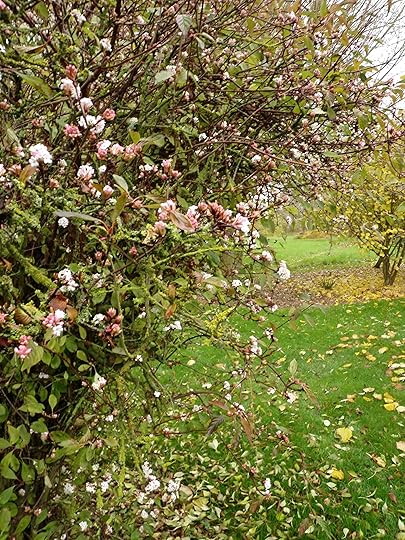
Viburnum x bodnantense in flower, late November. If only the camera could catch the scent!
Plants like that viburnum are gardening mega-stars, but your garden can’t just be filled with the Great and the Good. It would be like a record collection entirely composed of Bach, Beethoven, Beetles and Ellington. Personally, there are times when I feel like a spot of Stiff Little Fingers, or the Leighton Buzzards:
No dry ice,
And flying pigs,
At the Leighton Buzzard gigs…
Happy sounds! But I’m afraid I’m digressing. Where was I? Ah yes, plants that give interest but in a more restrained, less full-on fashion. One of my favourites is a narrow-leaved variety of a wetland shrub: Rhamnus frangula asplenifolia. This shrub has delightful narrow cut leaves and it grows well in very wet spots in the garden. Bulbs look good beneath it and the caterpillars of Brimstone butterflies feed on it. But in autumn for just a few days it looks magnificent with almost flaming yellow leaves. It’s also very good-tempered and needs virtually no maintenance. Sadly, it’s not very easy to find in local garden centres – you’ll have to shop around. But it’ll be worth it (not, remember, if you have dry ground).

Rhamnus frangula asplenifolia, a wet-loving shrub with delicate, finely-cut leaves, looks particularly spectacular in late autumn.
In every year, autumn brings surprises and this time round it has been a little fuchsia, Tom West, that Maisie bought quite cheap, as a rooted cutting, at a local garden centre in the spring. She stuck it in a pot and it has flowered all summer and now the coloured foliage is getting even better. I think it looks particularly good above the two rather pissed-off-looking frogs, at the base of the pot. Mark you, if I’d had to carry something that heavy for six months I’d be a touch fed-up, too.

Fuchsia Tom West flowers all summer and turns a wonderful rich hue in autumn
Finally, another bought-in delight. We grow red-hot pokers very well in all but our dampest soils; they provide good flowers and foliage for most of the summer. But they tend to tail-off in the autumn, but with a notable exception: Kniphofia rooperi, which is still flowering six weeks after we bought it from our favourite specialist nursery, West Acre Gardens, in Norfolk. Over the past twenty years we’ve got a lot of stuff there: the prices are always reasonable, the plants healthy and the choice huge. Oh yes, and most important of all: and the staff are always helpful and cheerful. We’d be lost without them.
For those of you who are new to gardening , I’ll do the second of my beginners’ guides next week, when I return from Scarborough Museum, where I’m doing a talk on The Making of the British Landscape. What an interesting topic. Should be a sell-out. Maybe I should write a book about it…?
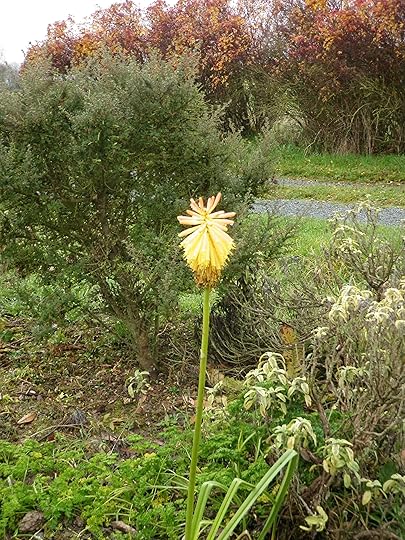
The red-hot poker, Kniphofia rooperi reserves its full flowering until well into autumn.


November 21, 2012
The Autumn Clear-Out
Houses have their spring cleans, gardens their autumn clear-out. Personally, I don’t go over-board on my autumn clear-out too early, because if you dead-head everything in the borders, the poor garden birds are denied their seed larder for the winter. And rumour has it that this is going to be a hard one (although as I write, it’s warm and pouring with rain). So I make a gentle start, with a little light pruning.
In recent years it has been unusual for us to have even a light ground frost in September, which I’ve always regarded as the fourth month of summer. In fact, autumn doesn’t really get into its stride until October. By November we’re busy cutting things back, especially where they’re in any danger of snapping-off in the gales that tend to start about then. In mid-November we bring all the sheep down from the top land and separate the rams (tups) from the ewes. We do this after six weeks; otherwise lambing tends to drag on and on. So we now know that the very first lambs will appear on or about March 2nd and the last by April 14th, 2013. In reality, most will be born in the second, third and fourth weeks of March; thereafter, things will rapidly calm down. In our experience it’s very unusual to have any lambs born at all in the sixth week of lambing. This year we’ll be lambing 94 ewes.

Our three rams tightly confined after tupping. The colours on the back of their necks indicate their blood-lines.
Rams, indeed I think this probably applies to most male mammals, including humans, behave rather strangely when forcibly removed from female company. I suppose some men might sit around and stare moodily into the fire, but rams are very different. The ewes have gone (with barely, I might add, a backward glance), so the chaps immediately decide to fight each other – and it doesn’t matter who: fathers take on their sons, nephews their uncles. Either way, they’re all in for a good mutual bashing. So, directly after tupping has finished, you never, ever, put rams together in the same field, because if you do, they’ll charge at each other and one usually gets killed. Most farmers confine them closely for four or five days – so close that they can’t charge and head-butt. This doesn’t stop them trying, and in the process they’ll smash hurdles and rip the strongest rope. It’s no good even offering them water for at least a day – or they’ll destroy the bucket and trough. On the second day, they’ll usually take food and water and a few days later I sometimes enlarge a tightly confined pen. It varies from year to year, but I never release them back into their field after less than seven days confinement; sometimes, especially when they’re young and frisky, it can take twice that.

Half-way through pruning the espaliered pears, showing the summer’s growth to be removed. The long mound to the right is the main asparagus bed (top growth was removed the previous week to counter the over-wintering of the pest, asparagus beetle).
In November, I make a start on my winter pruning marathon. I usually begin with the espaliered apples and pears that line the path through the vegetable garden. In some years I do an initial pruning later in July, once the terminal buds have set, but this year I was too busy filming, so it didn’t get done. Anyhow, I’m nearly finished now – if the rain will ever stop. I don’t normally prune my fruit trees much, as I reckon it causes too many disease and congestion problems; but you don’t have any option with espaliers. So the aim is to produce nice spurs with fat blossom buds. Most people try to achieve short, compact spurs. I prefer them a bit longer, as it allows the sun to reach the fruit better and makes them easier to pick. It also makes it easier to spot the appearance of woolly aphid – a particular problem in heavy, clay soils.

The pleached lime ‘raised hedge’, before its annual autumn pruning in late November or early December.
As I get older, I try to vary the jobs I do around the garden, otherwise my muscles tend to set in a lump. So when I’m digging the vegetable garden (which will be in early December, once the frosts get underway in earnest), I’ll also start pruning the small ‘raised hedge’ formed by four pleached broad-leafed lime trees. We planted these trees seventeen years ago and they’ve been a very great success – and look wonderful in winter as dark, knotty beings – something weird out of an Arthur Rackham picture. They’ll be ready to cut-back as soon as their leaves fall, which is already well underway.
For what it’s worth, I don’t think of the autumn clear-out, as tidying-up after summer. No, it’s all about getting ready for the new year and the spring that follows. It’s a time for thinking ahead, for optimism. At the risk of sounding insensitive, I have to concede that I don’t really ‘do’ melancholy. I’d go mad if I did. Or write poetry…

Twink poses in front of newly pruned espaliered apples.


November 15, 2012
Meet an Old Friend of Mine: Alan Cadbury
Like with all old friends, it’s difficult to recall when precisely I first met Alan. I think it may have been on one of those interminable trans-Atlantic flights, back in the 1970s, when I used to make regular trips to Canada. In those days I had a job at the wonderful Royal Ontario Museum, in Toronto – a place for which I still have a very soft spot. But like most expats, I used to dream of home, and it must have been ‘round about then that Alan first crossed my path. I suppose I must have admired him from afar, because it was a very long time before I learned his name. In fact, for several years I thought he was called Chris, but eventually I discovered the truth.
One of the things that appealed to me about Alan was where he came from. In case you haven’t already guessed, he was a Lincolnshire Fenman, born and bred. In those days, we’d often discuss England and Canada, and as we chatted away, the similarities between the two places grew and grew. It was something about the wide-open spaces, the vast flat fields of wheat and the intermittent towering grain silos, that dominated the scene, like so many Ely Cathedrals. Peoples’ attitudes, too, were similar: Canadians have acquired a dry and usually gentle sense of humour, which maybe reflects their strong Scottish roots. Fenman, too, have a wonderfully laid-back sense of humour: verging, I sometimes think, on a developed sense of the absurd.
Alan is more obsessive than me. I tend to be impatient. My idea of hell (which is probably what I’ll be condemned to do throughout Eternity) is to uncover two articulated toe bones, knowing full well that they’ll be attached to a foot, a leg and a complete skeleton, which will take a good three days to expose. Alan would relish such a revelation, as I discovered when I met somebody very similar to him when working on a Christian Anglo-Saxon churchyard at North Elmham, in Norfolk, back in 1970. Having said that, Christian burials are a yawn to excavate: at least those Pagan Saxons had the imagination to bury nice things with their stiffs…
Alan had had some interesting adventures in his life, and I well remember jotting a few of them down in a notebook, intending, one day, to work them up into a sort of collaborative memoire. But then we discovered Flag Fen. And that happened in the nick of time. In fact Maisie and I were even contemplating getting out of archaeology, altogether. In our blacker moments we’d come up with a scheme to brew home-made ‘country’ wines (elderflower, apple, parsnip etc.) on a commercial scale. We’d refer to the potential wine enterprise as the ‘OP’, or Other Project. She didn’t know about it then, but I had Alan’s memoirs in mind as the other Other Project (or OOP?), which I’d write-up in the evening and on weekends. We’d almost arranged the initial finance for the OP, when Flag popped out of that dyke, and both the OP and OOP were placed on the back-burner.
I didn’t see much of Alan until about 2009, when I read a wonderful detective story by Elly Griffiths, called The Crossing Places. Elly had kindly noted in her Acknowledgements that the story was based around the discovery and excavation of Seahenge, the Holme-next-the-Sea timber circle, and my book: Seahenge: a quest for life and death in Bronze Age Britain. Alan had read Elly’s book, too, and phoned me up, late one evening, just as I was getting ready for bed. That was typical of him. I couldn’t get him off the phone. But, it would seem he’d loved it: said it was a real page-turner. Then he went on to tell me (at interminable length) that he’d met someone almost identical to Dr. Ruth Galloway, Elly’s forensic archaeologist heroine, when he was teaching on a course up north somewhere – I think near Bradford. He held forth about her and I almost had to remind him she was fictional. Anyhow, I’m not sure they’d ever have become close friends. Yes, they were similar, but Alan sometimes fails to connect – which is something I’ve observed in other very focussed archaeologists – and I don’t think that’s a very endearing trait.
By now, I’m thinking, you’re probably asking why on earth I’m blogging about an old friend from my past, who doesn’t seem to have made much of an impression out in the real world? If you Google ‘Alan Cadbury’ (which I admit I’ve never done), I bet you won’t find lists of archaeological books and publications, because the sort of sites he digs are commercial. They’re almost invariably subject to confidentiality agreements and only see the light of day as so-called ‘grey literature’: spiral-bound documents in the Historic Environment Record, buried deep in the archives at Town and County Halls. I suppose, in the eyes of the world, he is a bit of a nonentity. But that doesn’t seem to worry him. In fact I imagine he’ll be pretty pissed-off that I’ve written this post. And it’ll probably cost me half a dozen pints of bitter when next we meet. Still, I’m fairly certain he’ll have a higher profile soon, and then he’ll just have to learn how to deal with it. He’ll just have to bloody well cope. I admit, he can irritate me intensely at times.


November 14, 2012
Flag Fen, 30 years on
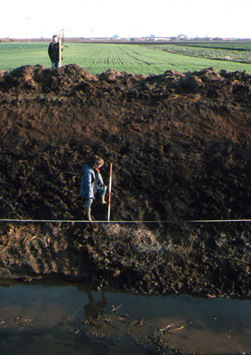
Flag Fen the day following its discovery in November 1982. Here David Gurney (now County Archaeologist of Norfolk) stands behind the spoil-heap left by the Anglian Water Board excavator that had just cleaned-out the dyke. At the top of the dykeside you can just make-out an orange layer, which was the make-up of a Roman Road (the Fen Causeway), built in AD 60. Maisie Taylor’s lower foot rests at the base of the Bronze Age buried soil, her left foot is at the base of the Bronze Age timber layer (still not yet visible in this picture). The water in the bottom of the dyke is at about half a metre below Sea Level (and we are 35 miles inland).
We discovered the extraordinary Bronze Age site at Flag Fen, Peterborough, exactly 30 years ago. To be honest I’m not certain of the precise date, but I think it was around the 3rd, or 4th of November, 1982. I’ve described that moment several times and I won’t repeat myself here, but you can read it in the ebook and in Flag Fen: Life and Death of a Prehistoric Landscape. But the point I want to make here, is that its discovery wasn’t an accident. It was part of a detailed survey of recently cleaned-out Fenland drainage dykes, which at the time (and with admirable originality) we called the Dyke Survey. That survey has been comprehensively written up by Charles French[1]; I had the idea of the survey and wrote a bit of the report, which is why my name (perhaps rather cheekily, in hindsight) appears on the title page. Incidentally, I’ve just heard that Charly has recently been honoured with the award of a Professorship at Cambridge. WELL DONE PROF CHARLY!!!
I had the idea of doing a dyke survey after I’d taken our team to Holland, where we collaborated in a big excavation at Assendelft[2], an early Iron Age project organized by the University of Amsterdam. To this day, I don’t know how I persuaded English Heritageto let me take the team abroad, but they did – and we had a wonderful time – and discovered Grolsch beer (which tasted very much better than the modern stuff with the same label, which is brewed in England). While we were at Amsterdam we were taught about Dutch-style dyke survey, which involved picking up artefacts along the edges of flooded dykes. They keep their fenlands very much wetter than we do. Anyhow, the principle was the same: to discover sites that are still buried and wet.
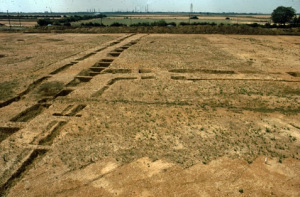
Bronze Age field boundary ditches, as excavated at Fengate in the summer of 1976. On the horizon are the chimneys of the Whittlesey brickworks. There’s a long hedge in the middle distance, in 1989 we discovered that this runs very approximately parallel to the Bronze Age post alignment, about a metre below it. The flag fen platform is less than half a mile from the excavations, in the direction of Whittlesey.
So we returned home and the following year started the dyke survey, in July, I think it was. Over the summer we made some remarkable finds, often of really old, Neolithic and Mesolithic sites, along the edges of buried ‘islands’. Then, in the autumn, we found Flag Fen and life, for me at least, hasn’t been the same since.
The 30th anniversary of Flag Fen was celebrated yesterday on Radio 4’s excellent Making History series, which also celebrates its 30th anniversary this month. At the end of a very good programme the two guest speakers, both distinguished academics made rather disparaging remarks about the Flag Fen crowd-funded excavations. I have to say, I thought their remarks verged on the haughty. Yes, we’d all love to open our excavations to everyone, and for free. Indeed, if I was receiving a large university grant, that’s precisely what I’d do. But the fact is, over the past thirty years, Flag Fen has received more than a million pounds of public money and I personally think there comes a time when one has to call a halt. After all, there are other worthy projects in England, that urgently need excavation and research. That’s one of the reasons it was decided to go down the crowd-funded route: as an experiment. And, happily, it was an experiment that worked: the participants had a good time, and the archaeology was professionally excavated, to a very high standard. The same will go for the report. So yes, it was funded by subscription, but the charges were very low and it’s far more important that somebody does something soon, because the site is rapidly drying-out and most of it won’t be there in thirty years’ time.
So get real, you academics. Climb out of your ivory towers and take a closer look at the modern world: you’ll discover it’s not all gloom and doom. There are a lot of good things going on out there, and (dare I say it?!) they’re not all as elitist as you…
[1] C.A.I. French and F.M.M. Pryor, The South-West Fen Dyke Survey Project 1982-86 East Anglian Archaeology, Report No. 59 (Fenland Archaeological Trust, Peterborough, 1993)
[2] L.L. Therkorn, R.W. Brandt, J.P. Pals and M. Taylor, ‘An early Iron Age farmstead: Site Q of the Assendelver Polders Project’, Proceedings of the Prehistoric Society, vol. 50, 1984, pp. 351-74


November 9, 2012
Time Team. The Great War: the great leveller
Next Sunday is Remembrance Sunday: 11/11/12. At 4.40 in the afternoon Channel 4 will be broadcasting the programme we filmed at the Machine Gun Corps training camp at Belton Park, just outside Grantham, Lincolnshire. I’m not sure how this will affect the rest of the final series (Series 20) when it’s eventually screened, hopefully next January. Maybe they’ll repeat or re-edit it, maybe not. I just don’t know. But I do know that the decision to show it on Remembrance Sunday is a good one. We made the film with reverence – and I think that comes across – certainly in Phil’s performance, at the close of the film. He was genuinely very moved, as was everyone who witnessed what happened.
One of the things that Time Team does (oops, I should have said ‘did’) to those of us who are part of the Team, both on and off screen, could be called ‘total immersion’. Yes, we’re making a film, but like Method actors, we’re also completely and utterly involved. You can’t do it any other way. You’re either in, or you’re out (and the chances are, you’re out for good, if that happens). And that of course was what happened in the trenches. It really was total immersion then. In fact it made our escapades look positively superficial. Plus there was the ever-present element of extreme danger. Death lay around every corner. And filth: mud and decaying bodies everywhere.
Now I wouldn’t dream of comparing the making of a Time Team film to life in the trenches. That would patently be absurd, but even in our very small way, we found over those twenty years, that the pressure of having to produce a good film in just three days was a great leveller. Our shoots weren’t like feature films, where the great stars retreat to their swanky trailers (or as we’d call them in the UK: caravans). No, we were all in it together and in the process we made life-long friendships which will survive for decades to come. And these friendships ignored all barriers: so archaeologists didn’t just mix with archaeologists and film crews with film crews. I’ve made loads of friends among cameramen and sound-recordists, not to mention Directors, Assistant Producers, researchers, runners etc. In fact these friendships set me thinking when we were filming at Belton.
My grand-father, Lt. Col. Walter Marlborough Pryor DSO was for a time the Commanding Officer of the Royal Warwickshire regiment; in fact he was promoted to C.O. in the trenches of the Somme. In theory, of course, there’s a big divide between officers and men. In camps at home they eat, sleep and socialise in separate quarters. But on active service those barriers soon break down. You don’t salute on the front line as that tells any enemy sniper that there’s an officer present. And officers (especially senior ones) make better, more telling, targets – for obvious reasons. I’ve spoken to friends who were soldiers once, and the officer/men thing gets abandoned quite quickly when guns start firing in anger. So to return to my grand-father, his closest, best friend was his batman (valet/servant) in the trenches. After the Great War he became his driver and right-hand man. I’ve never seen a less master/servant type of relationship: they were friends, close friends. I didn’t realise it when I was a child, but I was witnessing one of the long-term effects of that brutal conflict: the rapid breaking-down of the rigid Edwardian and Victorian class structure. WW2 pretty much completed the job. Of course that’s not to say that British snobbery has been finished-off. Far from it. But at least now it’s just based on wealth: there’s no implication that the upper echelons of society are superior in any other way. In fact, I’m far from certain I envy them their money: do I honestly want endless oysters and Champagne? It’s the rarity of them in my life that makes each occasion special.
I think we’re slowly beginning to understand to what extent the Great War altered the modern world. But it has been a slow process. Again, I used to think that you couldn’t reach a balanced historical assessment of any major event for about fifty years. I wonder now whether that shouldn’t be seventy or eighty – maybe closer to a full century. And why? Because we’re all living far longer and the one aspect of life that changes more slowly than any other, stares back at us from our mirrors, every morning. Like it or not, we are all of us making and affecting history, even long after the events in question took place. And that is why the cutting-short of so many young lives was - and still is – such an appalling tragedy.
Some photos I took while we were filming, back in May:
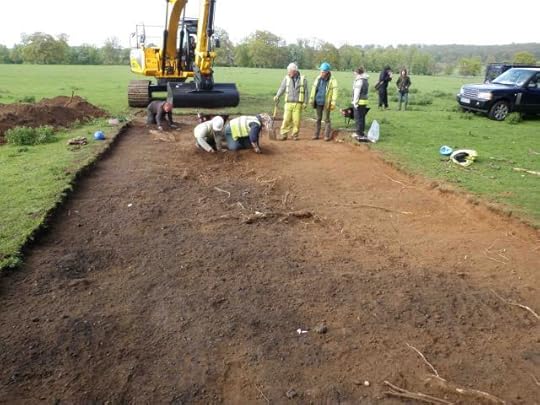
The actual digging was very challenging. There was archaeology just below the surface, where there were also loads of roots and other obstacles. The darker soil closer to the camera marks the edge of a lost building.

A typical tray of finds, with sherds of white-glazed pottery, fittings from buildings and a glass bottle.
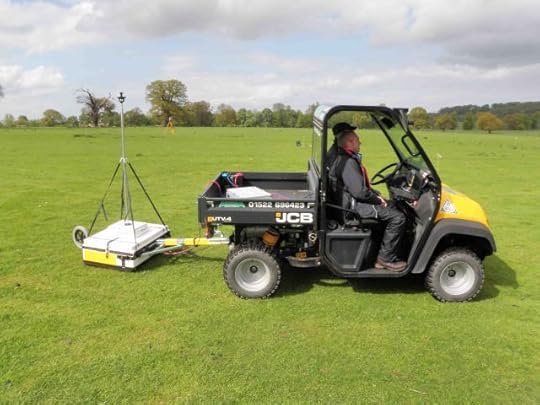
We made extensive use of GPR (Ground Penetrating Radar), which was towed behind a mini-tractor, which housed the laptop that recorded the data.

A Vickers machine-gun. This was the standard machine-gun used by the British Army in WW1


November 2, 2012
Autumn Leaves
I suppose it’s natural to want to extol autumn colour. After all, the main flush of changing leaves is relatively rapid – usually no more than a week or two after the first frosts. In North America the fall happens faster than does our autumnal change, cocooned as we are by the warm swirling waters of the Gulf Stream. I have to say the colours along the eastern seaboard of Canada and the U.S. are truly remarkable – if rather short-lived. I’ll never forget standing in a farm gateway outside Washington DC and staring open-mouthed across a field to a wood cloaked in cascades of screaming scarlet – the leaves of Virginia Creeper (Parthenocissus quinquefolia) that were taking advantage of the sunny aspect of the woodland edge. Sumac (Rhus glabra), also along the edges of woods in New England, can look stunning when set against the orange and red hues of Canadian Maple (Acer rubrum); it grows well in Britain, but can be invasive on certain soils. Our poor old elder bush (Sambucus nigra) is its native British equivalent and by comparison looks positively dowdy – but having said that, I don’t think you can’t make flower or berry wine from Sumac – in fact I think its sap is poisonous. The British native Field Maple (Acer campestre) isn’t quite so spectacular as its Canadian cousin, nor is it so vigorous or so large, but I do like its delicate foliage and its soft yellow tints in autumn. I think it’s an excellent smaller tree and I’ve planted dozens around the edges of our wood. With any luck they’ll help screen the 400 or so ash trees behind them, that’ll probably start dying in a year or two’s time (see my heartfelt rant against the brain-dead politicians who allowed it to happen).
As I said, people like to praise autumn colours, but I also enjoy autumn textures, which are so different from those of later summer. In earlier summer (before roughly mid-June) the leaves in woods and hedgerow are not a uniform green, as they are after that. But in autumn, texture and variety returns: stems become visible, many large ornamental grasses are in their full tasselled glory, and of course there are those colours. So in our garden we like to plant for autumn contrast, not just colour. We love the lush – almost early summer green – of the wet-loving Swamp Cypress (Taxodium distichum), a native of the southern U.S. States, such as Louisiana. Later in the autumn they do indeed change colour – to a rich amber, then dark brown.
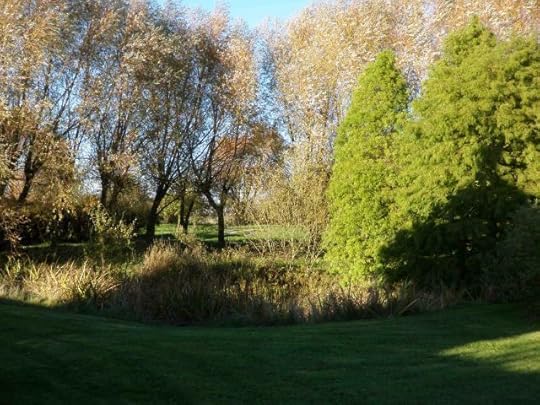
Swamp Cypress trees still in full leaf on the edge of the (dry) pond
Late flowering clematis also come into their own in autumn, and we are particularly fond of Clematis maximowicziana, which grows up the pergola on the back of the house. It’s one of the clematis you don’t have to prune annually. It’s also a superb plant in its own right and ours provides a winter home to at least two pairs of nesting wrens. Now it’s in full flower and looks absolutely stunning. I love the way its green foliage and clusters of white flowers contrast so vividly with the autumnal hues all around it.
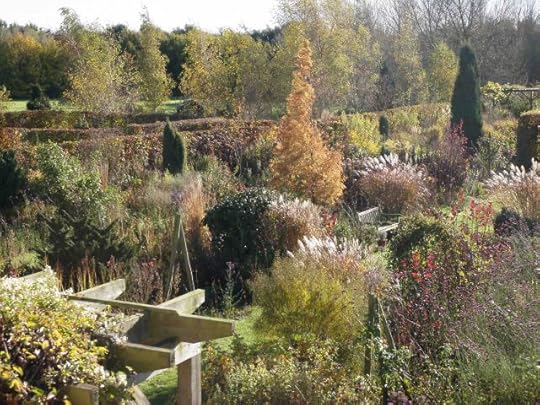
The garden in mid-autumn. Note the clematis in flower on the pergola roof (left, foreground)


October 31, 2012
Britain Begins by Barry Cunliffe
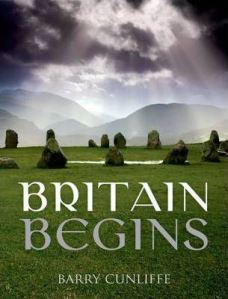 Britain Begins is the title of Professor Sir Barry Cunliffe’s latest book from Oxford University Press. In theory it costs thirty quid, but you could probably get it for closer to twenty. Either way, it’s unbelievably good value for money, with some 500 pages and hundreds of excellent plans, drawings and monochrome photos. And of course it’s produced to Oxford University Press’s exacting and very high standards. The author is the acknowledged leading authority on the Iron Age.
Britain Begins is the title of Professor Sir Barry Cunliffe’s latest book from Oxford University Press. In theory it costs thirty quid, but you could probably get it for closer to twenty. Either way, it’s unbelievably good value for money, with some 500 pages and hundreds of excellent plans, drawings and monochrome photos. And of course it’s produced to Oxford University Press’s exacting and very high standards. The author is the acknowledged leading authority on the Iron Age.
Even so, all of this sounds rather daunting: a mega-volume by a mega-archaeology star. But please don’t be put off. For a start, the book is very well and clearly written. It’s also completely jargon-free. Rather like the author himself, it’s very learned, very well-informed but always very approachable. But it’s not a particularly easy read: it won’t drift over you, like, say an Ian Rankin novel. You’ll have to concentrate, especially if you’re still new to archaeology, but I can assure you, it’ll be well worth the effort. Well worth it.
The book begins with a brief review of early archaeology. The main story begins when the Ice Ages ended, around ten thousand years ago, then Barry takes us on a quite stunning ride through the ages, starting with the hunter-gatherers of the Mesolithic, then the first farmers (Neolithic), then the Bronze, next the Iron Age and then the Roman ‘Episode’ – a chapter title which reminds us that Britain was only a part of the Roman Empire for some three and a half centuries. Thus far our journey has taken eleven chapters. Then the story resumes with an account of Celtic and Anglo-Saxon Britain, followed by the arrival of the Northmen (the Vikings), who included, of course, the Normans (their name is derived from the words North and Man).
Barry has had a long interest in Britain’s links to the continental mainland. His view is anything but insular – seeing regular contacts being maintained in the South-West, Wales, Ireland and South-Western Scotland, with the Atlantic approaches – areas such as Spain, Portugal, land around the Bay of Biscay, Brittany and Normandy. Eastern areas of Britain and large parts of Scotland were in regular contact with people all around the North Sea basin, and further north, into Scandinavia. But these contacts didn’t just come and go. They were remarkably consistent and have played a major role in the way that British culture – or rather cultures – developed. Today we British are still remarkably diverse; although this isn’t at all apparent if you happen to have been born and brought-up in the homogeneous south-east – for which one can blame the influence of London.
I think it’s the author’s clear vision of a Britain whose past is remarkably complex and unexpected that I find so inspiring. There isn’t a hint of complacency, nor of nationalism. I can’t recommend this book enough. But a word of warning: if you do decide to get it for yourself, don’t open the parcel until after Christmas, because your partner and/or your children won’t appreciate it if, during the tinsel festivities, your mind is permanently stuck in the Mesolithic…


October 25, 2012
Appalling News: Ash Trees are Threatened and Politicians are Brain-Dead
The Forestry Commission have just announced that a deadly disease of native ash trees has been imported into Britain and has escaped and been found on their land in East Anglia. In fairness, the Commission staff are moving heaven and earth to stop/contain it and have done much to raise the public’s interest in the threat. This development potentially marks the start of a process that will lead to the permanent mutilation of the British Rural landscape. Dutch Elm Disease was bad, catastrophic even, but this will be far, far worse. I am at my wit’s end: why, oh why, didn’t politicians do anything about it, before it was too late? The situation is exactly like it was when Dutch Elm Disease was imported. The pathogen was known to be across the sea and lay beneath the bark; so we on our little island continued to import trees with bark intact. It was rather like importing dead bodies with typhoid and storing them in a warm reservoir. For me, the ‘seventies were blighted by the sight of dead and half-dead elms in our hedgerows. They were rather like the rotting corpses of convicted felons that swung from gibbets at cross-roads in the 18th century: pointless and obscene.
Someting must be done to persuade our politicians that a week isn’t a long time in politics or in life: they must start to take a longer term view of our world. They mostly obsess about ephemeral things that have stirred the media, not about issues that really matter and affect us all. They fail to realise that what they decide (or worse, fail to decide) now, will shape our lives and landscapes for decades, even centuries to come. But do any of them get it? Do they? Hell no…


October 24, 2012
And Now For Something Completely Different: Broccoflower Fractals
With imminent unemployment staring me in the face I’ve been rethinking my world. Well actually, I haven’t. In point of fact, yesterday Maisie and I spent a very pleasant day in London, listening to a lecture on May Morris at the Society of Antiquaries, followed by two unbelievably expensive cups of tea in cardboard cups (no teapot, I ask you…) and a single slice of carrot cake – and all for £8.00! We enjoyed this repast in the very cramped tea-room at the Royal Academy, surrounded by people with, I suspect, more money than sense. So we gulped it all down, made a smart exit and spent the rest of the afternoon with an old friend and publisher, about which more (probably much more), later.
This morning I got up, determined to write further about the sad demise of Time Team, but when it actually came to it, I’m afraid I couldn’t be arsed. I know it’s expected of me, but to hell with it. I don’t ‘do’ whinge. The decision’s been made and life must go on, which it does, I’m glad to say, in its characteristically chaotic fashion. Anyhow, I was staring at the screen trying to summon up enthusiasm for the blog, when a voice on the Today Programme started talking about some recent research in Spain which has revealed the mathematical configuration of biological structures. This followed on an excellent documentary I watched, and must watch again sometime, on information (Order and Disorder), presented by the physicist Professor Jim Al-Khalili on BBC-4, yesterday at 9.00. It was excellent: well presented, non-patronising and full of information, like so many of the docs on that fine channel. All of this, the TV and the radio, reminded me of my vegetable garden and the extraordinary brassicas I’d grown under the impression they were ‘summer cauliflowers’ – as they were labelled in the garden centre.

The last head of our summer’s Romanesco
The first of these ‘summer cauliflowers’ was ready in mid-august and we cut the last one a week ago. I’ve looked them up and it would appear they are known as Romanesco, and have, quite rightly, been awarded the Award of Garden Merit by the Royal Horticultural Society. They’re also known as a form of Calabrese, broccoli or ‘Broccoflower’. Incidentally, the word broccoli comes from the Italian broccolo, a sprout. In actual fact Romanesco would appear to be an old form of Italian cauliflower. And like so many things from that most civilised of all countries, they’re superb and have been described as ‘heaven on a plate’. Try to get hold of old varieties and steer clear of F1 hybrids, which like most of the so-called broccoli sold in supermarkets, usually have very little flavour. First generation (F1) hybrids are strong, vigorous plants that respond well to loads of nitrate fertilizers. They look good, but taste of nothing.

Close up of the Romanesco, showing the floral structure of spirals-within-spirals
But back to those fractals. Fractals are mathematical entities of elegant simplicity, but enormous complexity. I can’t say I begin to understand them, but for further enlightenment on their application to archaeology go to: http://www.pasthorizonspr.com/index.php/archives/07/2012/lost-fractals-find-pharaonic-landscapes). The Spanish physicists have shown that cauliflowers (in particular) clearly show the form of their mathematical structure (fractals) in the shape of their flowers – and nowhere is this better seen than in the spirals-within-spirals of Romanesco. Happily I took a couple of photos earlier, before I heard of the Spanish research, and I think you’ll agree they look wonderful. In fact it was almost a pity to eat them. But only almost: lightly boiled (I hate steaming, it doesn’t release all the flavour, and also gives us both severe wind), then quickly turned over in a very hot pan with olive oil and garlic, finally into a cool-ish oven for 5 minutes, and you’ve got a dish fit for a king. To be honest, it tastes much better – better, even than it looks. And that leads me to another thought for those brainy Spaniards to explain: what do we know about the mathematics of flavour?


Francis Pryor's Blog
- Francis Pryor's profile
- 141 followers



